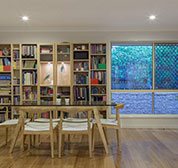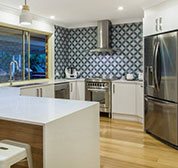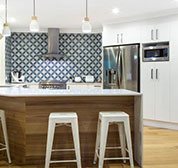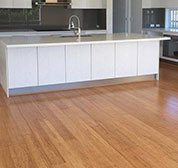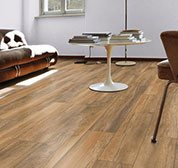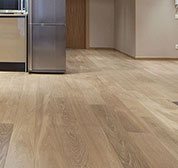Hardwood Flooring Guide
All you need to know about hardwood flooring The great variety in wood flooring choices comes from the species’ natural colors, stains and finishes, and even the wood’s tendency to lighten or darken subtly with age and sun exposure.
Overview
Solid HardwoodSolid wood flooring is 100% hardwood milled from lumber. As a natural material, hardwood reacts to changes in its setting, like moisture and extreme temperatures, which cause solid wood to shrink or expand. All solid hardwood can be sanded and refinished if needed over the years. Solid hardwood is not recommended for installation below ground level or in bathrooms.
Engineered Hardwood
Engineeredwood flooring is built up of layers of wood. It consists of three to ten layers, called plies, that are glued together. This multi-ply structure gives engineered wood superior stability, greater than solid wood, which reduces concerns associated with shrinking and expanding when temperature and humidity change. Engineered wood can be installed below ground level making it a great choice for finished basements.
Prefinished vs. Site-Finished Hardwood
Most hardwood flooring comes pre-finished for a no fuss, no mess installation. There's no dust from sanding, no fumes from chemicals, no waiting for the finish to dry. These floors are warranted to last longer than site-finished floors–typically 5 to 35 years, for residential use versus 3 to 5. This is because factory applied urethane finishes are much tougher and longer lasting than site-applied finishes. If you like the look of site-finished flooring, but want the durability of prefinished flooring, choose a product with a square end and edge.
Design
Color
Species
Variances by species are as fascinating as they are beautiful, from the pronounced grain of oak and the more understated, clean look of maple. Exotics like lapacho, tigerwood and Brazilian cherry are striking and distinctive. They vary in hardness, which translates into durability. Consider oak, maple, ash or cherry for the greatest durability.
Widths
Hardwood flooring can come in strips or planks. “Strips” are board widths of less than three inches. “Planks” are three inches or wider. Board width dramatically affects the installed look of a floor. Wide width hardwood planks are lovely in a large room, but can overwhelm a small one. Select what works with the style and size of your room.
Edge Detail
The way the edges and the ends of the boards are cut is called edge/end detail. Options include square, microbeveled, eased and beveled. For a dramatic effect, select a beveled edge/end detail that emphasizes the definition of individual boards. Square edges/ends create a smooth and nearly seamless appearance.
Whether you choose high-gloss or low-gloss, neither will affect the durability or performance of hardwood flooring. Low-gloss and light-colored floors can hide the minor scratches that can accumulate over time. Higher gloss floors don’t hide scratches as well.
Style
Lifestyle
Room
Hardwood floors are versatile and beautiful, but they’re not the best material for every room. In bathrooms, humidity and the potential for pooling water can create problems. Solid or engineered hardwoods in half-baths with no shower or tub are at less risk from moisture.
Installation Area
With the exception of bathrooms and laundry rooms, solid hardwood flooring is great in any room on the ground floor or above. Below ground, in basements where air and moisture issues can be factors, only engineered hardwood, laminate or vinyl flooring are recommended.
Kids, Pets and Durability
Hardwood flooring can be durable and hard as nails, but sports shoes with cleats, a stone in a sneaker tread or pet claws are examples of things that can leave significant scratches. For hardwood flooring areas with high traffic, or in rooms off foyers, a please-remove-shoes-at-the-door policy is a helpful rule to institute.
Warranty
Due to the toughness of factory-applied urethane finishes, prefinished hardwood floors are typically warranted to last 5 to 35 years, versus just 3 to 5 years for site-finished floors.
Floor Care
Part of the beauty of hardwood floors is just how easy they are to maintain. Simply sweep and clean with a Hardwood & Laminate Floor Cleaner and a microfiber mop.
Budget
Hardwood Visual Quality
Species and Specialty Visuals
At the high end of the price range, you'll find greater consistency and fewer visual defects, and specialty visuals like color-washing, hand-sculpting, and finishes that produce deeper, richer colors. Higher-end hardwood offers more exotic types of wood, such as Merbau, and other domestic exotic species.
Engineered Products
With engineered hardwood, the number of layers in the core and the thickness of the face are the two primary performance and cost drivers. At the lower cost range, expect to see three layers, at the mid-price range, five layers, and at the high end, look for seven layers or more. As the thickness of the top layer or face of the product increases, cost will typically increase as well, providing you the ability to sand and refinish if you ever need to, just like solid hardwood.
Floor Removal
Don’t forget to factor-in the cost of removing and disposing of your old floor. Depending upon where you live, the floor you are removing and your installer, budget around AU$25.00 per square metre to have it removed and hauled away but it can be more or less depending on the floor type and labour costs in your area.
Installation
Construction & Installation Options
Concrete and Moisture
Installing a hardwood floor over concrete that has too much moisture is a common mistake. This occurs frequently in new construction where the concrete has been power washed and/or when new concrete hasn't sufficiently dried. Refer to the installation instructions for more information.
Expansion Space
Be sure to leave sufficient room for expansion around the perimeter of the room. This is necessary to accommodate for the expansion and contraction in the wood due to temperature and humidity changes.
Access to Installers
We know how important it is to get the best installation to not only make your flooring look great but to give it the best chance to last. We also know how hard it is to find great quality installers, that is why we have created a tool for so you can access our database of professional installers.








